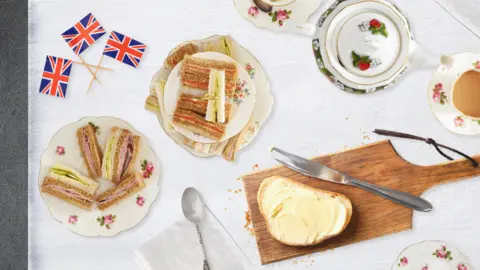From jelly to hummus: a history of street party food
 BBC
BBCWith communities across the country expected to celebrate the Coronation this weekend, perhaps nothing better reflects the changing face and taste of the nation than street parties throughout history.
From fruitcakes to couscous, here's a look back at how street party fare has evolved over the centuries.
Street parties have their roots in the 18th Century, with another popular monarch. "King George III was very, very good at interacting with his people," explains food historian Pen Vogler. Lots of parties were arranged for his jubilees, with some prisoners released and given money to toast his health.
The food was rustic, donated by local dignitaries to the poor. Typically, roast beef was topped with a slice of plum pudding.
The World Wars
The menu at 'Peace Parties' following World War One was similarly unadorned. The mainstay was bread and butter and fruitcakes. Attendees drank tea, "although if there were gentleman present, there would have been a little brown jug with something in it, to encourage attendance," notes Vogler, author of Scoff: A History of Food and Class in Britain.
Communities pooled their rations to celebrate the end of World War Two, but 'make do' dishes were common: cake made with powdered egg, the 'National Loaf' and Woolton Pie. Invented at the Savoy Hotel and named after Lord Woolton, Minister for Food, the meatless pie topped with potato pastry was widely loathed.
Queen Elizabeth II's Coronation (1953)

Although post-war rationing continued until 1954, people were allowed to purchase an extra pound of sugar for the Queen's Coronation. The availability of what we would now call processed food - in the form of tinned and packaged products - increased the variety on offer. Bread and butter was livened up with a variety of meat and fish pastes, and jelly was teamed with custard to make trifle.
The most famous dish to come out of the Queen's crowning - one that would become a mainstay at street parties - was Poulet Reine Elizabeth. Also known as Coronation Chicken, it was created by florist Constance Spry and cordon-bleu chef Rosemary Hume for a competition. The mixture of mayonnaise and curry showed the slowly widening palate of the British people.
Silver Jubilee (1977) and Wedding of Charles and Diana (1981)

By the late 1970s, packaged food had come to dominate the street party. Photos from the time show bread and butter replaced by branded sweets and cakes, some traditional and British, others more recent imports: Kit-Kats, Coca-Cola and Angel Delight.
"I think it's the era where the packaging, the glittery gold foil, becomes almost more important than the food inside it" explains Vogler. Serving up a homemade trifle was seen as unfashionable.
On many tables, the grand jelly had been replaced by the ultimate British party food: crisps in a bowl.
Wedding of William and Kate (2011)

By 2011, the wave of packaging had started receding. "There's a sense that bringing some homemade brownies or a carrot cake is a sign that you're really doing something for your community," says Vogler, "Everyone is so busy, time is so precious, and you've spent it putting it together for everyone."
As well as local delicacies, by 2011, British tastes had expanded. Tables were piled with bhaji, hummus, couscous and more.
"The concept that British celebration food is exclusively historic, traditional British food had disappeared by this point," says Vogler.
Platinum Jubilee (2022)

So what makes for a 21st century street party? Vogler suggests that the pandemic might see an increase in finger food: canapés, cheese straws, stuffed potatoes, things that can be enjoyed without sharing crockery. A wider variety of diets might also be accounted for, whether they're eco-friendly, vegan, gluten free or allergy conscious.
The winner of the Platinum Pudding competition combined sophisticated flavours like amaretti with British mainstays like jelly and custard. King Charles and Queen Consort Camilla took a more savoury approach when selecting their Coronation Quiche, filled with spinach, broad beans and tarragon. The lard, the royal social media team noted, can be substituted for vegetarians.
Once seen as fare for commoners, street party food is now more about eating well and having a good time with your neighbours.
Vogler says they are a way of forging bonds, "making a community that works, that can eat together and move forward together."
Additional reporting: Bethan Head. All images subject to copyright.
